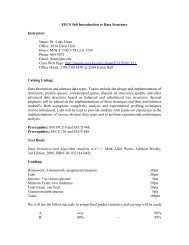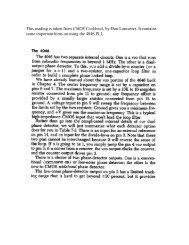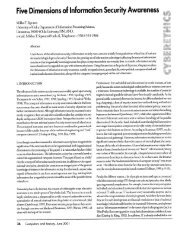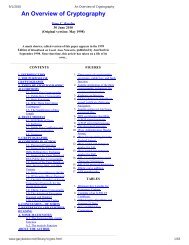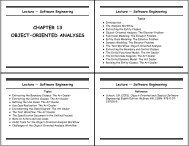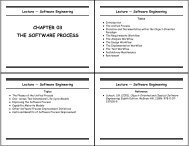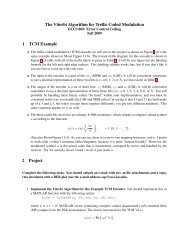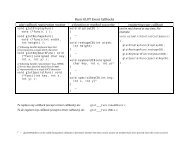CHAPTER 08 REUSABILITY AND PORTABILITY
CHAPTER 08 REUSABILITY AND PORTABILITY
CHAPTER 08 REUSABILITY AND PORTABILITY
Create successful ePaper yourself
Turn your PDF publications into a flip-book with our unique Google optimized e-Paper software.
Reuse Concepts● On average, only about 15% of any software product serves anoriginal purpose● The other 85% in theory can be standardized and reused infuture products● Reuse rates• Theoretical upper limit of 85%• Reuse rates of 40% can be achieved in practice● A product is portable if it is significantly easier to modify itto run on another system configuration (compiler, hardware,operating system) than recode it from scratchImpediments to Reuse● Software professionals would rather work from scratch thanreuse• Known as not invented here (NIH) syndrome• Management can address this issue: Financial incentives topromote reuse● Many developers would be willing to reuse provided they couldbe sure no faults would be introduced• Exhaustive testing of potentially reusable routines● How to effectively store and retrieve components to reuse• Database solutions• E.g., choosing an appropriate sort routine● Reuse can be expensive• Three costs: Cost of making something reusable, cost of reusing,and cost of defining and implementing a reuse process• Costs increase reported from 11% to 480%Impediments to Reuse● Legal issues can arise with contract software• Using a component of a client’s product in a new product for adifferent client• Client owning software that is reused for another client• Copyright violation of the first client• Not a problem with internal software● Reuse of commercial off-the-shelf (COTS) components• Developers are not given the source code• Software that reuses COTS components has limited extensibilityand modifiabilityObjects and Reuse● A well-designed object is the fundamental building block ofsoftware● It models all aspects of a particular real-world entity(conceptual independence or encapsulation)● It conceals implementation of both its data and operations(physical independence or information hiding)● Object-oriented paradigm utilized correctly• Resulting modules (objects) have informational cohesion• This promotes reuse




